How to Do Deep Work Consistently (Without Burning Out)
Learning how to do deep work consistently is one of the most powerful productivity strategies you can master. Deep work—intense, uninterrupted focus on cognitively demanding tasks—is the cornerstone of high performance and creativity.
Yet, many ambitious professionals struggle to sustain it without burnout. In this guide, you’ll discover actionable deep work techniques, effective strategies to build deep work habits, and proven methods to maintain sustained attention without cognitive fatigue.
By understanding the neuroscience behind deep concentration and designing intentional routines, you’ll not only improve your ability to focus deeply but also elevate your overall performance.


What Is Deep Work and Why Does It Matter?
The Science of Deep Work: How It Boosts Productivity
Deep work operates at the intersection of neuroscience and productivity. Engaging in deep work triggers focused cognitive processes, activating the executive functions of your brain—primarily within the prefrontal cortex.
Neuroscientific research supports that when you dedicate undivided attention to complex tasks, you enter a flow state. In this flow, your cognitive stamina peaks, significantly enhancing productivity and creativity.
Furthermore, deep work strengthens neuroplasticity, your brain’s ability to reorganize itself and form new neural connections. This enhanced cognitive capability isn’t just short-term; it compounds over time, fostering mental resilience and deeper mastery in your chosen domain.
Studies from institutions like MIT and Stanford have shown that regular engagement in focused, uninterrupted work improves working memory and decision-making ability. When you understand how to do deep work effectively, you not only get more done—you think more clearly and with greater depth.
Deep Work vs. Shallow Work: Understanding the Difference
Deep work and shallow work are two distinct productivity methods. Deep work is characterized by sustained attention on cognitively demanding tasks, such as strategic planning, writing, designing, or coding.
Shallow work, on the other hand, involves tasks that are often performed with divided attention—emails, routine meetings, administrative tasks, and social media management.
Shallow work isn’t inherently negative but becomes problematic when it dominates your schedule, limiting your capacity for meaningful progress. Recognizing this difference is critical; it allows you to prioritize tasks effectively and ensures your most impactful work gets your best mental resources.
By identifying when you’re slipping into shallow work, you can reallocate that energy to high-value tasks. Deep work isn’t about being busy—it’s about being effective. And the more you learn how to do deep work, the more capable you become of producing results that matter.
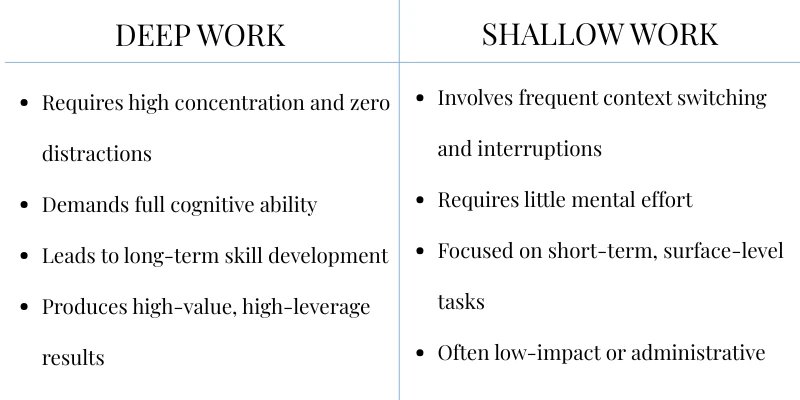

The Hidden Cost of Constant Distraction
Constant distractions incur a cognitive cost known as attention residue—your brain’s tendency to remain partially focused on a previous task. Each time you’re interrupted or shift tasks, your cognitive load increases, draining your mental stamina and weakening the quality of your work.
Over time, this fragmentation accumulates. It not only reduces your output but also increases mental fatigue. You may feel like you’ve worked all day without making meaningful progress. This is a clear indicator that you’re working from a place of distraction, not depth.
Eliminating distractions not only protects your cognitive resources but also increases the quality and efficiency of your output. Understanding how to do deep work involves actively managing these distractions and creating an environment conducive to sustained attention.
How to Prepare Your Mindset for Consistent Deep Work
Building a Performance Identity Around Deep Work
A performance identity means aligning your self-concept with high-performance standards, particularly around deep work. To cultivate this identity, clearly articulate your goals and values, and consciously commit to the habits that support sustained, distraction-free productivity.
See yourself as someone who does deep work—not occasionally, but consistently. This belief reinforces itself through repetition. Each time you engage in focused, intentional effort, you cast a vote for this identity.
Recognize deep work as an expression of your professional self, not merely a productivity tactic. This mindset shift strengthens your intrinsic motivation, making consistent engagement in deep work easier and more rewarding.
Cultivating Deep Work Habits and Mindset
Deep work consistency is built through deliberate practice. Start by clearly defining your deep work rituals—time blocks, preparation steps, and recovery breaks. Habitually schedule these rituals into your daily calendar, reinforcing their importance.
Habits like device isolation, intentional breathing, or journaling your focus goals can serve as anchors before each session. Over time, these practices condition your brain to associate specific cues with focused performance.
Additionally, practice mindfulness or reflective techniques that enhance your mental clarity and focus. This habit cultivation fosters discipline, embedding deep work into your routine as second nature rather than a forced effort.
One of the best ways to learn how to do deep work consistently is by stacking it onto already-established habits. For example, after your morning coffee or right before your first work task, trigger a short ritual to begin your deep work.
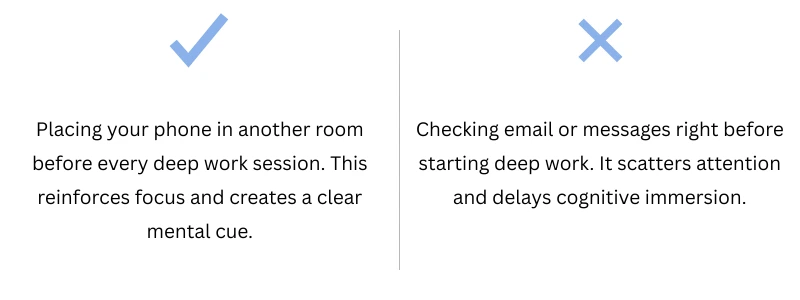

Training Your Attention Span to Avoid Burnout
Just as physical stamina improves with consistent training, your attention span and cognitive endurance can be deliberately expanded. Begin by setting realistic deep work session durations—initially 25–45 minutes—and progressively increase these intervals over time.
Neuroscience shows that attention is trainable. When you minimize context switching and sustain focus, you strengthen neural pathways responsible for executive function. Over weeks, this translates into longer stretches of clear, undistracted thinking.
Incorporating short, strategic breaks prevents mental fatigue. Employ methods like the Pomodoro Technique initially to manage cognitive load and gradually transition to extended deep work sessions as your mental stamina grows.
It’s crucial not to conflate deep work with just working for long hours. Deep work is defined by intensity and immersion, not duration. You could spend four hours “working” but only generate thirty minutes of true cognitive output if your attention is fragmented.
Knowing how to do deep work involves mastering this balance—building up your attention span over time while resting strategically to avoid burnout.


Setting Up the Ideal Deep Work Environment
Workspace Design for Optimal Focus
Your physical environment profoundly influences your cognitive performance. Design your workspace intentionally—prioritize natural lighting, ergonomic furniture, and minimalistic aesthetics. A clutter-free space translates to reduced mental clutter, facilitating better concentration.
Remove visual noise. Every object within your field of vision should either serve a purpose or reinforce your mindset. For some, this means a clean white desk and a single notebook. For others, a closed door and noise-cancelling headphones.
Consider aspects like desk placement, comfortable seating, and visual simplicity. Each element should serve your goal: creating a space optimized for deep work and sustained productivity.
Even small adjustments—like adjusting your monitor height, reducing ambient noise, or setting up a specific scent you associate with deep focus—can improve your ability to stay in the zone.
Tools and Tech for Deep Work Productivity
While technology often contributes to distraction, strategically chosen tools can bolster your productivity. Use applications such as Notion for organizing thoughts, tasks, and notes, or Freedom and Cold Turkey to block distracting websites and apps.
Brain.fm provides scientifically optimized music designed to enhance focus and flow state productivity. These auditory environments can support deep cognitive immersion, especially when used consistently.
Other tools to support deep work include analog timers, minimalist text editors, and high-quality headphones. Make these tools part of your ritual—not just conveniences, but switches that initiate a shift in mental state.
Choosing and mastering the right tools ensures your tech enhances your performance rather than hindering it. The key is intentionality: every tool should reduce friction and increase your ability to focus deeply.
If you’re interested in a free digital product that gives you an organized system and resources to create a distraction free work environment, you can access that here.


How to Eliminate Digital and Physical Distractions
Distractions directly undermine deep work consistency. Start by identifying your most common distractions—smartphones, social media, email notifications—and create systems to manage them.
Set clear digital boundaries. Silence notifications, use site-blocking extensions during deep work periods, and communicate your unavailability to others. Batch-check your messages outside of focus hours. This not only protects your flow but trains others to respect your deep work schedule.
Physically, maintain an organized and minimalist workspace, removing objects that do not directly support your tasks. Keep only what you need in your immediate environment. Visual clutter—even benign—can subtly fracture your attention.
Managing distractions proactively safeguards your attention, ensuring each deep work session delivers maximum value. Mastering how to do deep work also means mastering the removal of everything that isn’t aligned with it.
Creating an Effective Deep Work Schedule
Time Blocking and Deep Work Rituals
Time blocking is a foundational strategy for deep work productivity. Allocate specific, non-negotiable periods for deep work sessions within your calendar. Respect these blocks as you would critical appointments.
Use visual cues, such as color-coded blocks, to distinguish these sessions. Stack them during your peak cognitive hours—usually late morning or early afternoon—and protect them ruthlessly.
Deep work rituals reinforce this structure. These rituals might involve brief mindfulness exercises, physical warm-ups, or short goal-setting moments before each session. Ritualizing your schedule primes your mind for deep engagement, enhancing productivity and consistency.
When you ritualize your entry into deep work, your brain begins to anticipate focus. Over time, the gap between starting and entering flow shrinks. Learning how to do deep work consistently becomes more about rhythm than willpower.
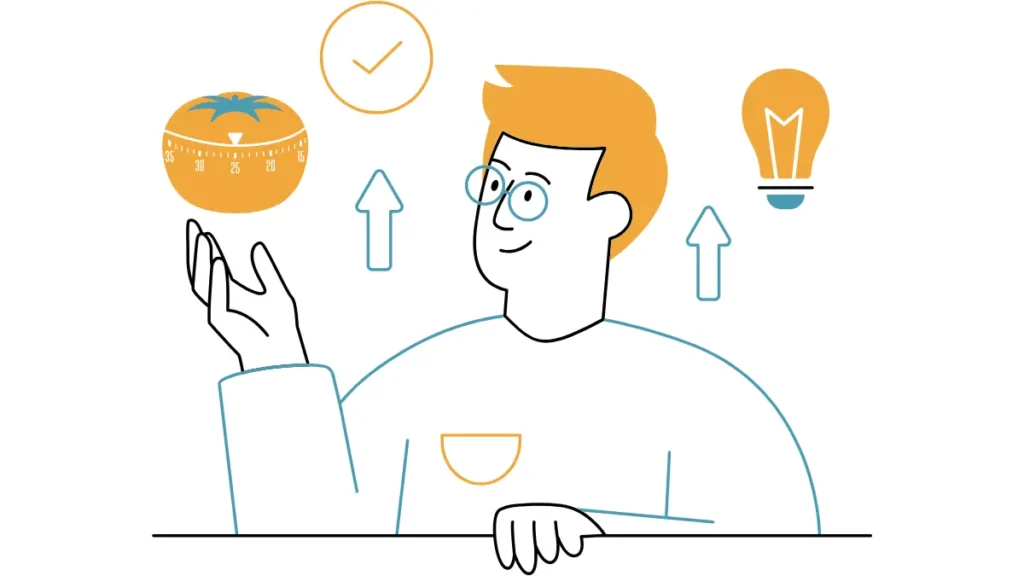

Integrating Pomodoro Sessions for Extended Focus
Initially, incorporating Pomodoro sessions can be highly effective in building deep work capacity. The Pomodoro Technique segments work into focused intervals, typically 25–45 minutes, separated by short, structured breaks.
This structure prevents mental fatigue while improving cognitive resilience. For beginners, Pomodoros help train attention and maintain momentum. As your ability grows, you can extend intervals to 60–90 minutes of deep concentration.
Use the breaks to reflect, stretch, or hydrate—avoid jumping into shallow tasks like checking your phone. Each Pomodoro should feel like one uninterrupted chapter of cognitive output.
This integration allows you to transition smoothly into longer, uninterrupted deep work sessions, striking a balance between productivity and mental well-being.
Balancing Deep Work and Rest for Maximum Performance
Consistent deep work without sufficient rest inevitably leads to burnout. Productive rest breaks are as critical as the work itself. Schedule deliberate rest and recovery periods—take short walks, practice meditation, or simply step away from your workspace.
Use strategic rest to replenish cognitive reserves. This might include midday naps, nature exposure, or even passive journaling. Anything that slows your nervous system down and resets your mind.
Building high-performance routines that respect both your cognitive demands and your body’s need for recovery is essential. This intentional balance not only sustains your productivity but also enhances your long-term performance and prevents burnout.
The more you understand how to do deep work, the more you realize it’s not about doing more—it’s about doing less, better. And that means resting as intentionally as you work


Techniques for Entering Flow State Consistently
Recognizing the Flow State: Psychological Cues
To understand how to do deep work at a high level, you need to recognize what it feels like when you’re in the flow state.
Flow—popularized by psychologist Mihaly Csikszentmihalyi—is a mental zone where time dilates, distractions fade, and your attention becomes fully absorbed in the task. This state is the core of deep work productivity.
The psychological cues of flow include:
- Loss of time awareness
- Complete focus without force
- Effortless momentum
- A merging of action and awareness
These sensations aren’t accidental. They’re triggered by specific environmental, emotional, and neurological conditions.
While flow can feel elusive—especially for students balancing classes and distractions—certain cues and practices make it more accessible. To consistently enter flow, you must prime your mind and environment with intention.
Cognitive Load Management and Mental Clarity
Your ability to enter deep work hinges on cognitive clarity. When your brain is overloaded—either by multitasking or residual thoughts from previous tasks—you’re far less likely to experience sustained attention.
This is where Cognitive Load Theory becomes crucial. Your brain only has so much capacity in its working memory. Every distraction—whether it’s a stray thought, open tab, or unchecked message—adds weight.
To manage cognitive load:
- Pre-clear your mind: Before any deep work session, spend five minutes journaling or writing out stray thoughts. This acts like a cache clear for your brain.
- Use minimalist systems: A cluttered workspace, app overload, or bloated task system creates noise. Systems like Bullet Journaling or minimalist Notion dashboards allow clarity to rise.
- Batch shallow work: Handle low-focus tasks (like email) in one block to reduce attention residue—where traces of one task bleed into the next.
Enhancing Flow Frequency with Structured Practices
Getting into flow once is chance. Doing it consistently is a system. Here’s how high performers structure their work to make flow a habit:
- Start with ritual: Ritual anchors your focus. Whether it’s brewing a specific type of tea, lighting a candle, or opening Brain.fm—ritual signals to your brain: it’s time to focus. Over time, your brain will associate this with flow.
- Work in timed blocks with breaks: Structure your focus sessions in defined blocks of time, followed by intentional rest. Beginners often benefit from the Pomodoro technique—four cycles of 25 minutes on, 5 minutes off, then a longer break. As your cognitive stamina improves, gradually transition to longer blocks (60–240 minutes).
- Optimize your environment: Your deep work environment setup matters. Lighting, sound, and ergonomics affect neurochemistry. Use tools like noise-canceling headphones, ambient lighting, and applications like Cold Turkey or Freedom to lock out distraction.
- Match difficulty to skill: The flow state lives at the edge of challenge. Tasks that are too easy induce boredom, too hard create anxiety. Regularly stretch yourself slightly beyond your current level to trigger engagement.
- Use entry ramp tasks: Instead of jumping into the most complex task, begin each session with an entry ramp—a small, related task that activates the same mental circuits. For writers, this might be freewriting; for coders, small syntax fixes.
Flow isn’t magic. It’s a byproduct of precision—of design, intention, and aligned inputs. Learning how to do deep work isn’t just about brute focus; it’s about building momentum until the mind forgets to resist.


Preventing Deep Work Burnout: Strategies That Work
Recognizing Signs of Cognitive Fatigue Early
Burnout isn’t always dramatic. For deep workers, it often arrives subtly: procrastination you can’t explain, rest that doesn’t feel restorative, or work that feels unusually heavy. These are signs of cognitive fatigue, and they precede full burnout.
Warning signs include:
- Inability to focus even with ideal conditions
- Irritability or mental sluggishness after short sessions
- Declining output despite effort
To do deep work consistently, you must become skilled not just at applying pressure, but at reading signals. Catching mental fatigue early allows you to recalibrate instead of crash.
One effective strategy during these moments is to pivot into productive procrastination—tasks that are easier on the brain but still advance your goals. Organizing notes, reviewing strategy, or doing light reading can keep momentum alive without pushing past your limits.
Instead of forcing output, you’re intelligently redirecting your energy until your cognitive stamina resets.
Designing Breaks That Actually Recharge Your Brain
Not all breaks are created equal. Scrolling social media or watching chaotic videos may stimulate your brain but don’t restore it. Breaks that reduce cognitive load and reset executive function are what your deep work schedule needs.
Three types of restorative breaks:
- Movement breaks: Walking—especially outdoors—reduces mental fatigue and activates the Default Mode Network.
- Stillness breaks: Meditation, breathwork, or simply closing your eyes for 10 minutes resets your neural circuits.
- Creative breaks: Sketching, listening to instrumental music, or slow reading can stimulate the brain without draining it.
Set a break structure into your deep work habits:
- After deep concentration, insert a 15-minute recovery period.
- Once per workday, block a longer 45–60 minute session to reset—midday walks are especially powerful.
Avoiding Common Deep Work Mistakes
Many high performers fall into deep work burnout because of avoidable missteps. Here are a few:
Mistake 1: Not cycling intensity
Trying to maintain high-focus sessions back-to-back for an entire day can lead to collapse. Alternate high-intensity blocks with lower-intensity administrative work or learning-based tasks.
Mistake 2: Over-scheduling deep work
Ironically, trying to over-optimize can lead to diminishing returns. Two to four hours of high-quality focus can outperform eight hours of scattered effort.
Focus on depth over duration. But that doesn’t mean you’re limited forever. Focus is a trainable skill — as your stamina grows, you’ll be able to handle longer, deeper sessions with less strain. Just like strength training, your capacity expands with consistency and intelligent pacing.
Mistake 3: No performance wind-down
Athletes cool down. Performers debrief. Deep work needs the same. Use the final 10 minutes of a session to review what was accomplished and prep the next step. This reduces cognitive closure issues and helps you re-enter the next session with clarity.
Mistake 4: Neglecting foundational inputs
Your cognitive stamina is only as strong as your sleep, hydration, fuel, and mental clarity. Precision habits around health aren’t optional—they’re the gatekeepers of consistency.
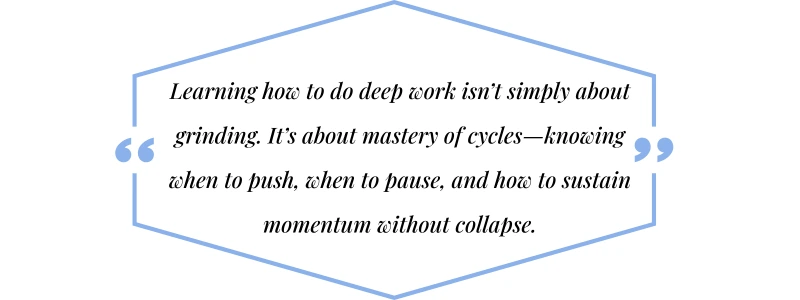

Advanced Deep Work Strategies for High Performers
Sustained Attention Training Methods
If you want to go beyond average and learn how to do deep work at a world-class level, you need to train sustained attention as a skill. This means building the neurological infrastructure to maintain concentration for extended periods.
Tactics for training sustained attention:
- Incremental exposure: Like weight training, you don’t start with 4-hour blocks. Build your sessions in 10–15 minute increments over weeks.
- Single-task reps: Practice doing one task to completion without checking anything else. Even in non-work settings. Cooking, cleaning, reading—treat them like focus reps.
- Visual timers: Use physical timers to externalize your effort. Watching time pass helps discipline the mind.
- Focus cues: Develop physical anchors (e.g., wrist pressure, stretching, or a breathing cue) that signal the brain to lock in.
Your brain is plastic—neuroplasticity guarantees that with repeated effort, sustained attention becomes easier. Don’t confuse low attention span with low potential. It’s trainable.
Leveraging Deep Work for Long-Term Mastery
Deep work isn’t just a productivity hack—it’s how mastery is built.
In Cal Newport’s framework, deep work is the way professionals differentiate themselves. It’s how you move from competent to elite.
Not through scattered hustle—but focused, deliberate effort toward high-value skills. Understanding how to do deep work at this level means applying it as a long-term strategy—not just a daily tactic.
To leverage deep work:
- Identify 1–2 core skills that will compound your career or craft.
- Use 70–80% of your deep work sessions to push these forward.
- Track progress weekly—not results, but consistency, quality, and challenge level.
Whether you’re building a business, writing, coding, or designing—you’re not just checking off tasks. You’re creating an identity of performance, one session at a time.
Implementing Reflective Practice to Boost Deep Work Effectiveness
What separates top performers isn’t just doing deep work—it’s learning from it.
Reflective practice is the process of reviewing how your deep work session went:
- What went well?
- What derailed you?
- What can you change next session?
This takes 3–5 minutes. But it creates a feedback loop that improves execution exponentially over time.
Use a post-session journal or simple Notion template with three questions:
- What was my focus rating (1–10)?
- What friction did I notice?
- What can I adjust tomorrow?
When practiced consistently, this builds internal clarity and makes every session a lesson—not just labor.
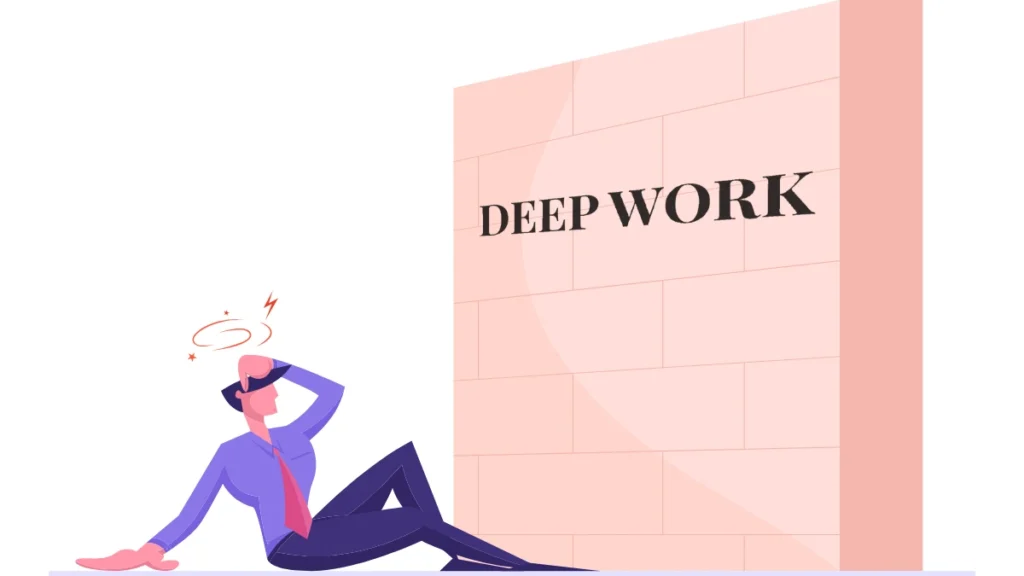

Common Barriers to Consistent Deep Work (and How to Solve Them)
Overcoming Resistance and Procrastination
Resistance and procrastination are two of the most common barriers to consistently engaging in deep work. To overcome these, first understand that resistance often stems from the perception of the difficulty or magnitude of a task.
Break down tasks into smaller, actionable steps that feel manageable and less overwhelming. Clearly define your goals and outline the immediate next step, which reduces mental friction and makes starting easier.
Creating a pre-work ritual can help condition your mind and body to enter deep work mode effortlessly. A brief meditation, a short walk, or even brewing a cup of tea can signal your brain that it’s time to focus deeply.
Establishing routines that minimize decision-making ensures that you consistently engage in your deep work habits, effectively overcoming resistance.
Procrastination often thrives in ambiguity, so bringing clarity to your tasks and responsibilities removes its foothold. Prioritize tasks clearly, placing your most demanding cognitive tasks in the highest-priority blocks.
This practice not only reduces procrastination but actively builds your capacity for sustained attention.
How to Maintain Consistency Amidst Changing Workloads
A fluctuating workload is another common barrier to mastering how to do deep work consistently. Your deep work schedule should be robust but flexible, designed to adapt rather than collapse under changing demands.
Establish clear priorities for your deep work blocks, identifying critical tasks ahead of time. Time blocking is particularly effective here, as it clearly delineates when you’ll tackle your most critical tasks.
Buffer zones around deep work sessions provide flexibility, allowing you to absorb unexpected tasks without completely derailing your schedule. Learning how to practice deep work amidst fluctuating demands involves proactive communication with colleagues and stakeholders, clearly setting expectations for your availability and response times.
Finally, maintaining a high performance routine that incorporates both productivity and restful breaks ensures you’re equipped to manage fluctuating workloads without succumbing to burnout.
Rebounding Quickly from Disruptions to Your Schedule
Even the best-laid plans can be disrupted. Learning how to do deep work consistently requires resilience and rapid recovery from interruptions. If your deep work session is disrupted, promptly acknowledge the disruption without dwelling on frustration.
Quickly assess and revise your plan, adjusting your remaining sessions or redistributing tasks if necessary.
Adopting the Pomodoro method deep work approach can help you quickly recalibrate your focus after disruptions. Shorter focus intervals followed by intentional breaks maintain cognitive stamina and sustain attention.
Additionally, practicing mindfulness techniques can improve your ability to regain focus rapidly after interruptions, enhancing your overall deep concentration strategies.
Regular reflection on your schedule disruptions helps identify patterns and create strategies to prevent them from recurring. Consider logging disruptions briefly, noting how you handled them and how they impacted your productivity. Over time, this reflective practice will significantly improve deep work consistency and resilience.


Practical Examples: Deep Work Routines from Experts
Cal Newport’s Deep Work Routine
Cal Newport, author of “Deep Work,” is an authoritative figure whose strategies on deep work productivity have significantly shaped the productivity landscape. His daily routine exemplifies how to do deep work with consistency and intentionality.
Newport meticulously time blocks his entire workday, dedicating lengthy, uninterrupted periods to high-priority intellectual tasks.
He advocates a strict shutdown ritual at the end of each workday, clearly marking the transition from deep, focused productivity to rest. Newport’s method also emphasizes a digitally minimalist workspace, eliminating distractions and reducing cognitive load.
His rigorous adherence to deep work techniques demonstrates how consistent practice strengthens cognitive stamina and leads to exceptional output.
Notable High Performers’ Daily Focus Rituals
Many high performers across various fields have adopted deep work habits that reinforce their productivity and creativity. For instance, Bill Gates famously practices “Think Weeks,” isolating himself periodically to immerse deeply in strategic thinking and creative problem-solving.
Gates’s method demonstrates how stepping away from routine tasks can amplify deep work productivity, providing substantial breakthroughs and insights.
Similarly, renowned writer Haruki Murakami maintains a strict daily routine, rising early to engage in several uninterrupted hours of deep writing. His routine combines sustained attention with productive rest breaks, including regular exercise, to prevent mental fatigue and ensure continued cognitive sharpness.
These practical examples underscore the versatility of deep work schedules and rituals. Each high performer tailors their approach, demonstrating how to do deep work in alignment with personal rhythms and professional demands.
Adopting elements from these routines can significantly enhance your deep work ability, ensuring both productivity and creativity.
Conclusion
Mastering how to do deep work consistently is more than adopting a productivity method—it’s about strategically designing a lifestyle around peak cognitive performance.
Deep work enables profound intellectual and creative breakthroughs, elevating your performance far beyond what shallow, fragmented attention can achieve.
To consistently practice deep work, clearly define your performance identity, cultivate disciplined habits, and thoughtfully design your environment to eliminate distractions. Integrate strategic scheduling, combining long deep work sessions with productive rest periods to maintain cognitive stamina and avoid burnout.
The integration of techniques such as the Pomodoro method, mindfulness, and reflective practices further enhance your deep work productivity, enabling rapid recovery from inevitable disruptions.
Ultimately, learning how to do deep work requires commitment and intention. By aligning your habits and environment with the demands of sustained attention, you establish a high performance routine that consistently delivers exceptional results.
Embrace these strategies and examples to build a deep work practice that not only improves productivity but enhances the quality and impact of your work, positioning you for lasting mastery and success.
FAQ: How to Do Deep Work Consistently
How long should deep work sessions last?
Effective deep work sessions typically last between 60 and 120 minutes, depending on your cognitive stamina and experience. Beginners might find 30–45-minute intervals beneficial, gradually extending their sessions as their deep work habits and ability improve. The key is sustained attention, not marathon sessions—quality always beats duration.
Can you do deep work every day without burnout?
Yes, but consistency demands intentional avoid burnout strategies. You must balance intense cognitive sessions with structured, productive rest breaks. Alternating deep focus periods with lighter tasks or scheduled recovery time prevents mental fatigue and ensures sustainable deep work productivity.
How to do deep work when my job constantly interrupts me?
If your job inherently involves interruptions, mastering how to practice deep work involves scheduling dedicated focused productivity sessions when interruptions are least likely. Clearly communicate your deep work schedule to colleagues, leverage time blocking, and establish clear boundaries to protect your concentration.
How to do deep work consistently when motivation fluctuates?
Fluctuating motivation is natural. The solution lies in building disciplined routines rather than relying on willpower. By cultivating structured rituals and clearly defining your goals, you anchor your ability to enter a flow state consistently—making deep work habitual, not dependent on motivation.






